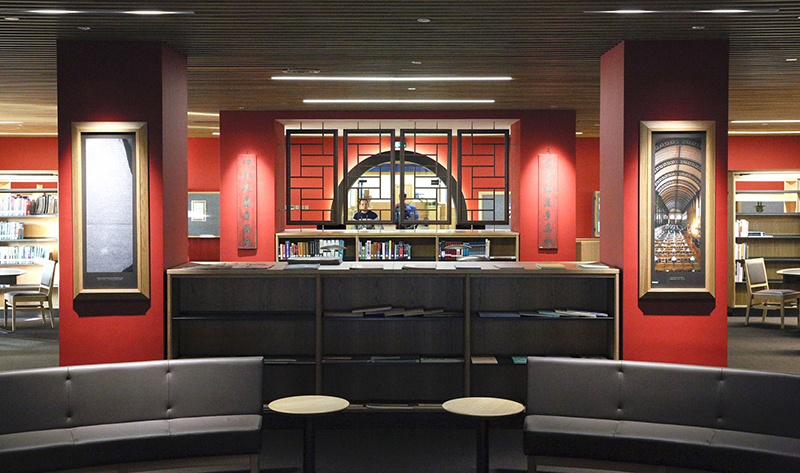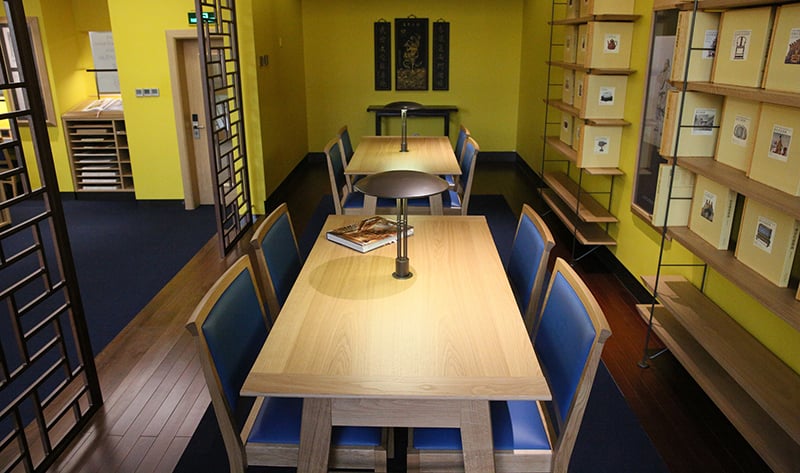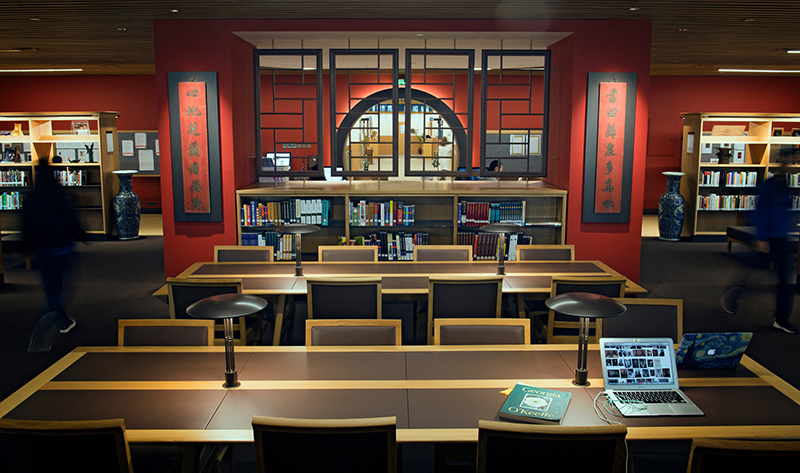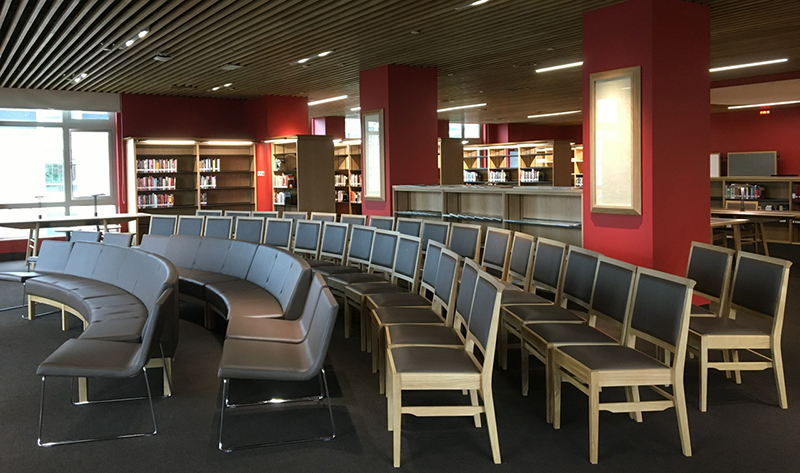The furniture schedule
An unprepossessing interior space was transformed with the use of colour and bespoke library furniture.
The simplest thing the design team could do was paint it in traditional Chinese colours, and use colour as a device to differentiate the different zones. The yellow glaze of a Song Dynasty vase is considered in Chinese tradition as amongst the most beautiful and prestigious colours, signifying neutrality and good luck, while the deep rich red of the ‘Moon door’ surrounds, which carries through most of the library, is the colour of good fortune and joy.
The bespoke library furniture schedule included oak reading tables and lecterns, leather upholstered seating, and oak bookshelves and storage units.
Some of the reading tables were smaller, with the distinctive Luke Hughes Mercury ‘tri-arc’ top and the stainless steel base from the Curzon range, adapted to carry a leather top, distinctive ‘upside down waterfall edge lipping and splayed-leg features intended to suggest a certain oriental flavour, all wired for power and data.
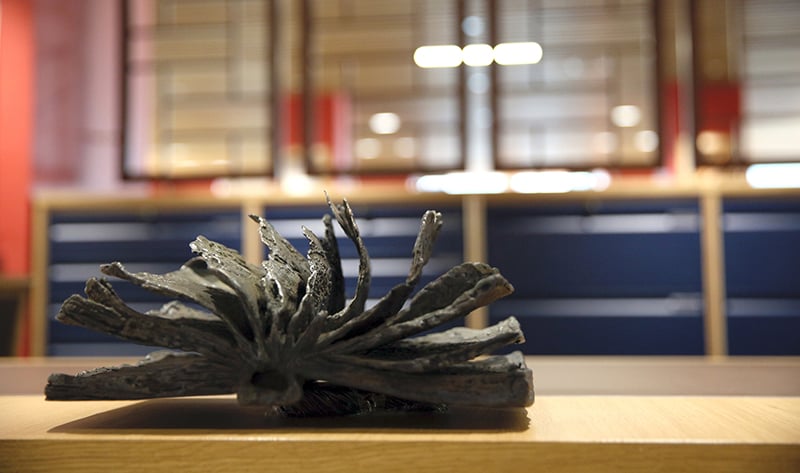
Power lessons
The positioning of the floor boxes (pull-throughs) was still uncertain at the time of making, so - considered somewhat surplus to requirements at the time - covered grooves were machined in all the legs to make sure cable could be run up whichever leg proved closest to the floor box.
We allowed for standard UK-sized cabling. This is approximately 8-9mm (5/16in) in diameter, but when the furniture arrived on site we discovered that the cabling installed was significantly thicker, up to 13 or 14mm (1/2in). So all the grooves were necessary, as it turned out.
The team at Luke Hughes also designed the fixed lights on the reading tables to maintain the understated Chinese look.
Interior environment
There was a conscious attempt in the design process to take some of the furniture forms illustrated in silk paintings from the Ming and Song dynasties and give them a contemporary twist, but the project needed more than just bespoke library furniture to create a vital academic environment, and it is rich with a range of decorative ideas that demonstrate the depth of our experience with libraries.
Artworks, which are considered fundamental to the success of the space. The project team, which included Academy Founding Principal Malcolm McKenzie and librarian Song Jingming, collected antiques from Beijing architectural salvage yards, and enhanced the columns with 24 long narrow pictures of libraries and literary icons round the world and throughout history.
Letter-carver Caroline Webb was commissioned to cut English-language quotes and aphorisms into slate, and Dong Han, a biologist and calligraphy teacher at the Academy, provided beautiful inkbrush lettering in Mandarin.
Aficionados will recognise the British Museum from the mid-19th century, when Karl Marx was writing Das Kapital there; the Strahof Library in Prague because that is the central Jesuit library in the world, and the Jesuits were the main link between China and the West from 1595 onwards; and even the Rosetta Stone, a translator’s library in itself being the link between cuneiform, Ancient Greek, and Ancient Egyptian language.
The decorative pièce de resistance is the double dragon door handles on the library entrance – ‘The moment when a student physically grabs hold of the sense of these cultural connections.’ Commissioned from Scottish sculptor, Jill Watson, the dragons themselves were the result of painstaking research, involving photography of ‘at least 300 dragons.’ In the final installation both Welsh and Chinese versions of the mythical animal breathe fire at each other across the doorway, embodying the cross-cultural communication at the heart of this centre for academic learning.
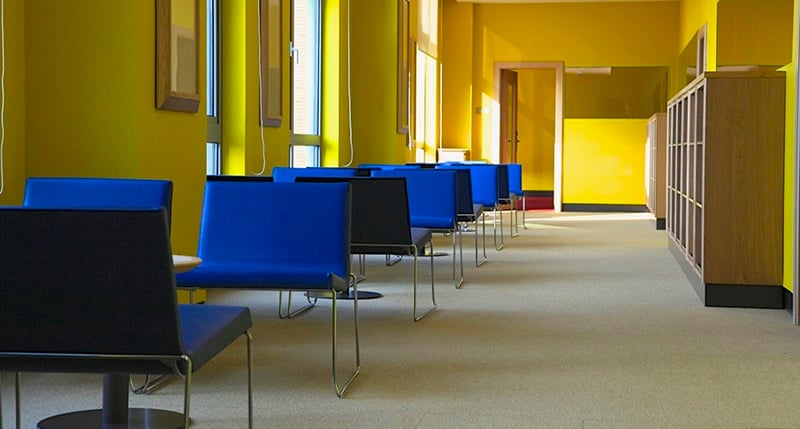
Production & delivery logistics
The preliminary interior design in place, the company found itself with four months to design, manufacture, deliver and install 24 tonnes of bespoke library furniture to the other side of the world. Such a schedule is every day business for our planning and logistics teams, using production co-ordination techniques put in place over many years.
16 UK workshops, plus some in Spain and Slovenia, were brought into the process. Every single stick of the 24 tonnes had to be designed to go into the lift cars. No one was going to be carrying all that furniture up the stairs.
The project, five container-loads carefully packed in the correct installation sequence, was delivered under budget and at precisely 8am on the very morning we had planned for and committed to six months before.
Astonishing feats of on-budget, on-time, right-first time, on the other side of the World is what we do.
Responses
The client was nothing short of ecstatic. ‘We commit to and value student learning that takes place independently, and the library is a case in point where our students can explore areas of interest, make connections and enjoy unexpected discovery,’ said Keystone Founding Principal Malcolm McKenzie. ‘Luke Hughes has turned our vision into a beautifully conceived, versatile, studious and stimulating environment.’
Director of Libraries Song Jingming’s comment perfectly expresses the genuine delight of both staff and students. ‘Places where the qi (energy) not only draws you in but also speaks of other eras (and values) are so rare. The Jin-dynasty poet, Tao Yuanming, wrote in “The Peach Blossom Land” about a fisherman who stumbled on a magical village where, on entering, visitors lose their sense of time and forget to leave. That is what the library feels like.’
Enjoy the article? Delve deeper into Luke Hughes & Company’s place in the Arts and Crafts tradition with the fascinating new book 'Furniture in Architecture' . Available through Thames & Hudson

